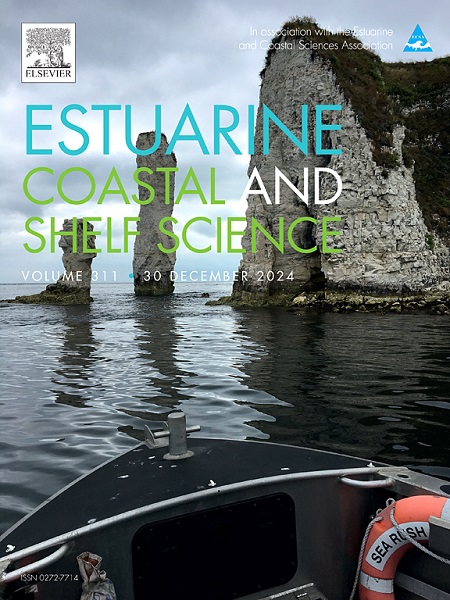Icelandic riverine freshwater distribution, offshore export, and alongshelf connectivity
IF 2.6
3区 地球科学
Q1 MARINE & FRESHWATER BIOLOGY
引用次数: 0
Abstract
This study models Iceland's shelf and surrounding ocean waters to quantify shelf distributions, flushing times, offshore exports (beyond the 400-m isobath), and alongshelf transports of Iceland's riverine freshwater. Analysis of the 2019 period divides the shelf into four quadrants and follows river waters delivered to each quadrant with tracked freshwater tracers that decay over time in open-ocean waters. Tracked freshwater thicknesses are large in the southwest quadrant and near major rivers in other areas. Freshwater is present around the entire shelf, but is less prevalent in the southeast quadrant. Many river waters can reach halfway around Iceland before being exported offshore; diminishing amounts can almost entirely circumnavigate Iceland. Annual average freshwater flushing times have an approximately seasonal scale at around 3 and 4 months for eastern and western river waters, respectively. Annual average freshwater exports are larger from northern shelf quadrants than southern ones. Average alongshelf freshwater transports are downshelf. Alongshelf connectivity is strong between most quadrants and moderate between the eastern quadrants. Regressions show how export and downshelf transport increase during upwelling-favorable and downwelling-favorable winds, respectively. Results indicate the Icelandic Coastal Current has robust buoyancy signatures and connected currents in western Iceland, and has generally weaker buoyancy and less-pronounced connected flows on the eastern side.

求助全文
约1分钟内获得全文
求助全文
来源期刊
CiteScore
5.60
自引率
7.10%
发文量
374
审稿时长
9 months
期刊介绍:
Estuarine, Coastal and Shelf Science is an international multidisciplinary journal devoted to the analysis of saline water phenomena ranging from the outer edge of the continental shelf to the upper limits of the tidal zone. The journal provides a unique forum, unifying the multidisciplinary approaches to the study of the oceanography of estuaries, coastal zones, and continental shelf seas. It features original research papers, review papers and short communications treating such disciplines as zoology, botany, geology, sedimentology, physical oceanography.

 求助内容:
求助内容: 应助结果提醒方式:
应助结果提醒方式:


